How Many Chia Plots Per Tb
How to Farm Chia Coin, Now With Pooling

The Chia cryptocurrency started
making waves in the storage industryin the early days, but diminishing returns and the lack of pooled farming were serious drawbacks. Now, arguably iii months too late, pooling has finally arrived. We've overhauled our guide for how to get started, as well as our hardware recommendations. Spoiler alert: You probably shouldn't purchase annihilation.
When
Chia trading went live, information technology looked like the hot new commodity, but things have changed quite a bit in the past few months. The total netspace for Chia rapidly expanded from less than ane exabyte when trading went live, and it now sits at over 32 EiB. The rapid scaling of May and June are now behind us, though pooling may change cause a resurgence. At least now it's possible to become something from Chia, fifty-fifty if you only have a few tens of terabytes, but with Chia well on its way to triple-digit EiB levels, don't expect much. In fact, BackBlaze went then far as to say Chia didn't brand sense, even with the 'free' 150PB of untapped storage the company currently has.
But don't permit that end you! If you're looking to bring together the latest crypto-bandwagon, here's how to get started farming Chia coin, with the latest updates at present in identify. That ways using the MadMax plotter to cut downward on plotting times, along with how to get started with a chia Pool.
Chia Farming and Mining Nuts
If you've dabbled in other cryptocurrencies before, Chia is a very different brute. Some of the fundamental blockchain concepts aren't radically different from what'southward gone before, but Chia coin ditches the Proof of Work algorithm for securing the blockchain and instead implements Proof of Infinite — technically Proof of Time and Space, but the latter appears to be the more pertinent gene. Rather than mining coins past dedicating large amounts of processing power to the chore, Chia merely requires storage plots — merely these plots demand to be filled with the correct data.
The analogies with existent-world farming are intentional. First yous need to clear a field (i.e., delete whatsoever files on your storage devices that are taking up space), and so you turn and seed the field (compute a plot for Chia), then… well, you expect for the crops to grow, which can accept quite a long time when those crops are Chia blocks.
Each Chia plot ends upwards being sort of like a massive, complex Bingo carte du jour. In that location's lots of math behind it, but that analogy should suffice. Each time a block challenge comes up, the Chia network determines a winner based on various rules. If your plot matches and 'wins' the block, you get the block reward (currently two XCH, Chia's money abbreviation). That cake reward is gear up to decrease every three years, for the kickoff 12 years, later on which the block reward will exist static advertizing infinitum. The official FAQ lists the advantage rate as 64 XCH per 10 minutes, and it will get cut in one-half every three years until it'south at 4 XCH per 10 minutes with a block reward of 0.125 XCH.
[Note: We've updated the math below based on the electric current netspace. 7/14/2021]
Your chances of solving a Chia coin block are basically equal to your portion of the full network infinite (netspace). Right now, Chia's netspace sits at roughly 32 EiB (Exbibytes — the binary SI unit), so i EiB equals two^60 bytes, or 1,152,921,504,606,846,976 bytes decimal, and 32 EiB equals 36.9 EB (exabytes, using x^18 for the SI decimal units). That means if you dedicate a consummate 10TB (10 trillion bytes) of storage to Chia plots, your odds of winning are 0.000027%, or 0.0000000271 if we drop the percentage part. If those sound like terrible odds, they are, simply the catch is that there are approximately iv,608 Chia blocks created every solar day (a rate of 32 blocks per 10 minutes, or xviii.75 seconds per block), and whatsoever one of them could match your plot.
Simple math can then give you the average time to win, though
Chia calculatorsmake estimating this far easier than doing the math yourself. A completely full 10TB HDD tin store 91 standard Chia blocks (effectually 101.4 GiB each). Again, don't get lazy and forget to convert betwixt tebibytes and terabytes, every bit SI units definitely matter. 91 blocks on a single 10TB HDD works out to maybe winning a block every 2 years (808 days). Actually, to be precise, it would have a theoretical 0.86% chance to win a cake each week, a 3.64% chance to in a cake in a month, and a 36.34% run a risk to win a block in a year. Only with netspace standing to increase, your odds will drib and yous could go years without winning anything — at least if you're solo farming.
Nosotros've heard from some people that dedicated over 100TB of storage to Chia back in May, who never earned a thing. And that was when the odds were five times ameliorate than at present, with prices more than double the electric current going rate.
Using a small 512GB consumer SSD for Chia plotting is a very bad idea.
Of course, luck comes into play. It's theoretically possible (though highly unlikely) to accept simply a few plots and win a cake solution immediately. It'south too possible to have hundreds of plots and go for many months without a single accustomed solution. Also, just because a plot wins in one case doesn't mean it can't win again, so don't delete your plots subsequently they win.
The law of averages should equalize over time, just the real trouble is that solo farming or mining basically sucks. It'due south why every major cryptocurrency has had pooled mining support for years now, which makes u.s. wonder: How on Globe did the Chia creators retrieve launching without pools was a skillful idea? Surely information technology didn't have annihilation to do with their own large pools of storage.
If you want to better your chances, you'd demand more storage and more Chia plots, which tin quickly escalate to big amounts of money. This is the standard cryptocurrency arms race that we've seen repeated over the by decade with hundreds of popular coins. The large miners — farmers in this case — want more of the total Chia pie, and blitz out to purchase more hardware and increase their odds of winning. Except, this fourth dimension information technology's not just a thing of buying more SSDs or HDDs. This time farmers need to make full each of those with plots, and that takes time, additional hardware, and a scrap of know-how.
Hardware Requirements for Chia Coin Farming
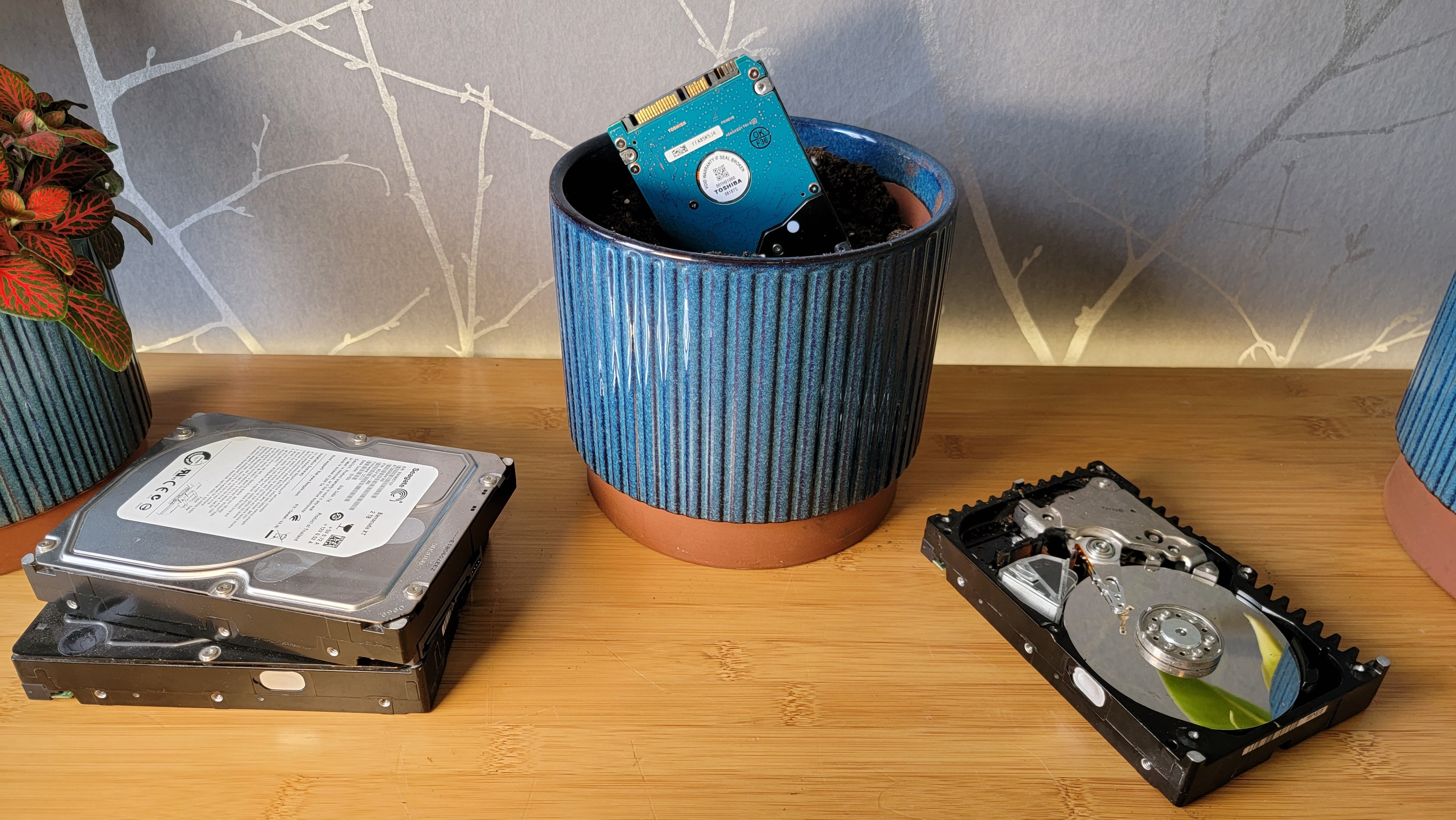
With Ethereum, once you lot have the requisite GPUs in hand, maybe some of the best mining GPUs, all you have to practise is become them running in a PC. Chia requires that whole plowing and plotting business organization, and that takes time. How much time? Early on, with the plotting software from the Chia devs, information technology would accept nigh six or seven hours per standard k=32 plot (twice equally long at k=33), with a very fast Optane 905P SSD, though it's possible to practise multiple plots at once with the right hardware.
You could plot straight to difficult bulldoze storage, but and then information technology can take over twice as long, and the number of concurrent plots you lot can do drops to basically ane per HDD. Also: Don't try plotting straight to a USB HDD; inefficiencies in the USB protocol hateful information technology can take more than than a mean solar day per plot, at least in our limited testing.
Things have improved in the past month or and so, however. The main change was the release of the MadMax plotter, an optimized solution that better scales to dozens of threads. If you lot have sufficient SSD capacity and speed, it might non aid that much, only it's at present possible to do sequential plotting and churn out finished plots in nether 30 minutes with the correct hardware.
The best solution is to have one, possibly 2, fast SSDs that are rated for high endurance. Enterprise grade U.two drives can piece of work, though we've washed testing with consumer SSDs every bit well as Intel'southward Optane drives. Using a small 512GB consumer SSD for Chia plotting is a very bad idea, because it volition vesture out very chop-chop — a single k32 Chia plot requires around 1.6TB of writes. That means a 512GB SSD rated for merely 150TBW could fail after just 100 plots! Intel's Optane 905P 480GB model in contrast is rated for 8.76PBW, though information technology as well costs about ten times every bit much as a small-scale 512GB model.
Anyway, yous utilize the SSD(southward) for the plotting, so transfer the finished plots to a big HDD. Chia's app will let you do that, but it can exist a chip choosy, and if something goes wrong like exceeding the temp storage space, the plotting will crash and yous'll lose all that work. Don't over schedule your plotting, in other words.
Each 101.iv GiB plot requires upwardly to 350 GiB of temporary storage, though in do we've managed to do a unmarried plot multiple times on a 260 GiB SSD. Boilerplate write speed during the plotting process varies, depending on your hardware, and MadMax will tend to push button a lot more data through the bulldoze in a brusk period of time. Plotting besides requires 4 GiB of RAM, more with MadMax, so college capacity retention sticks are par for the course.
Ultimately, the principal limiting factors for plotting volition be storage speed and CPU functioning and clocks, with retentiveness bandwidthe playing a office likewise. Based on our testing, a 2TB SSD (1863 TiB) can handle six concurrent plots going the "old way" and churn out perhaps 24 plots in a day, while MadMax can spit out more than 48 plots per twenty-four hours. Rather than chasing after a college capacity SSD, or multiple SSDs, plus more retentivity, we're going to get with MadMax. More on that below.
Note that nosotros currently do not recommend buying a lot of hardware to become into Chia farming.
Based on the requirements, hither are two sample builds — one for faster plotting and i for slower plotting. Notation that we currently practice not recommend buying a lot of hardware to get into Chia farming. The cost of storage tin can be loftier, and you need a lot of it if you want to have a chance, plus you lot need the rest of the system as well for plotting.
As we predicted a few months agone, based on what was happening in Cathay, HDD and SSD prices have also shot up. Your best all-time is to focus on price per GB, factoring in whether you lot'll need USB enclosures. When nosotros start wrote about Chia, HDDs started at around $0.02 per GB for 10TB drives. At present, we're upwards to around $0.03 per GB, and higher capacity drives can become for $0.035 per GB.
Thankfully, the hype is starting to wane and prices for high chapters drives aren't quite as bad these days as in May (where $0.045 per GB for 18TB drives was common). Nevertheless, while it might seem tempting to get with 14TB or larger drives, the significantly higher prices make that a poor choice. In fact, modest 5TB USB HDDs tend to be the sweet spot correct at present, as they're often still bachelor for around $100 ($0.20 per GB). Then that's what we're using.
Our baseline Chia plotting PC uses a six-cadre/12-thread CPU, and we've elected to get with Intel's latest Core i5-11400 simply because information technology's affordable, comes with a cooler, and should prove sufficiently fast. AMD's Ryzen 5 5600X would exist a proficient alternative, were it readily bachelor — correct now it tends to price nigh twice as much as the i5-11400, but it besides needs a dedicated graphics card (perchance one of the best graphics cards), and we all know how hard it can be to detect those correct at present.
For storage, we've selected a Samsung 983 DCT 960GB enterprise SSD that'southward rated for 0.8 DWPD (Drive Writes Per Day) for five years. That'southward around 1400TBW, which is plenty to create around 800–900 plots, at which signal your Chia farm should hopefully (maybe?) exist doing okay and maybe y'all'll be able to afford a replacement SSD. (Don't exist the subcontract on that!) Mass storage comes via six 5TB USB HDDs, because that's the most economical option. USB drives besides give you far more potential to calibration up to higher bulldoze counts, since you can add powered USB hubs. Alternatively, y'all can easily move your stored plots to a separate machine when a drive is filled if yous want.
The other components are basically whatever seems like a reasonably priced choice, with an eye toward decent quality. Yous could potentially use a smaller case and motherboard, or a different PSU also. If you plan to add more HDDs — potentially a lot more — of the internal SATA variety, that might likewise nowadays difficulties. This PC should support up to 6 internal SATA HDDs, though finding space in the case for all the drives could exist difficult.
At an estimated charge per unit of 30 plots per day using MadMax (around 45 minutes per plot, give or have), it should take almost nine days of solid plotting time to fill the half dozen 5TB HDDs. Meanwhile, the potential profit from 30TB of Chia plots (270 101.4 GiB plots, 45 per HDD) is now down to… wow. And that's "wow" in a not nearly every bit good way as it was back in May, long earlier pools were a thing.
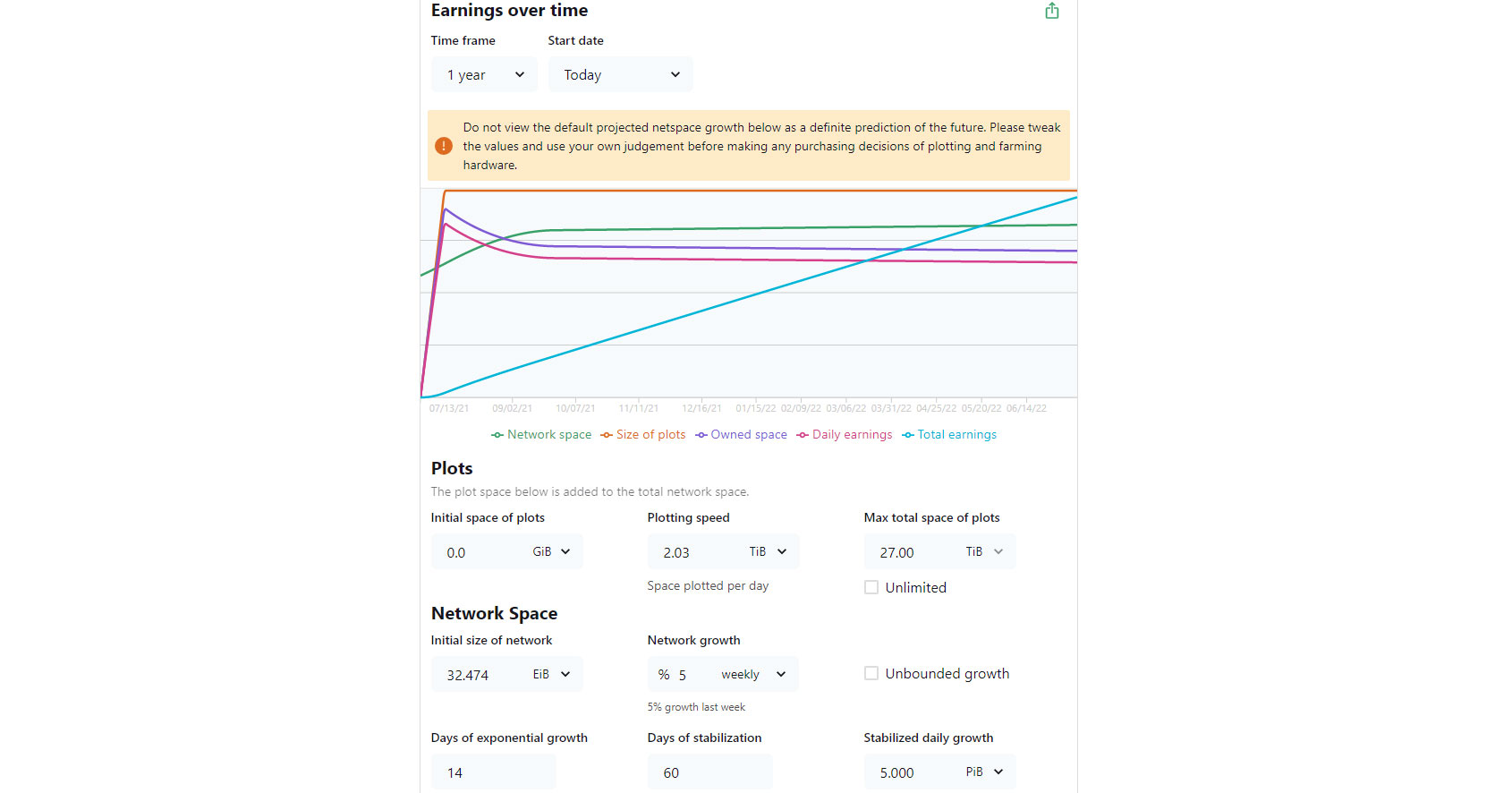
Things are definitely going to modify over fourth dimension. In that location will be more netspace, the price could driblet or increase, etc. Just in the past month, the potential profits have plummeted due to the increase in netspace and the drop in Chia's trading price. At this snapshot in fourth dimension, someone with 30TB of storage and 270 plots would potentially earn around $fifty per month. (In the early going, the estimate was well-nigh $1 per TB of plots per day, which was apparently way also high to sustain.)
Of form, if yous outset now and don't take any plots even so, best-case information technology will exist another ii or iii weeks before your drives are fully populated and farming on a puddle. How fast volition the netspace grow, where will it stabilize, what volition the cost of Chia be in the future, and how much will 30TB of plots make long-term? Those are all great questions, and the curt-term answer is that income volition almost certainly be even lower than the simple projection of $fifty per month.
You can use the advanced calculator to get a dissimilar projection. For instance, starting from 0 plots, plotting at three TiB per mean solar day, and filling up 30TB of drives gives a potential income of $225 over the next six months, and $450 for the year. Information technology could terminate up being a lot less than that; it might (maybe, big if) be worth more than than that. But we'd estimate a bare minimum of thirty months just to intermission fifty-fifty, and probably more like five years (unless Chia shoots the moon).
Desire to practice even more plots per day? The quickest way to go there is with more CPU cores, running at college clocks. This particular setup has a x-core CPU, again from Intel because of pricing considerations (no GPU required). Nosotros've kept the same RAM, thanks to the MadMax plotter, but doubled SSD capacity and endurance. This Samsung 983 DCT has the same 0.viii DWPD rating, but with double the capacity that means effectually 2800 TBW — enough for ane,750 plots by our math (give or take).
The higher CPU clocks and slightly faster SSD should be able to do a single plot in about 30 minutes, which ways effectually 48 plots per day. Simply we've also put in more USB storage, which now bumps the total cost to over $2,400.
Nigh of the remaining components are the same as earlier, though you could certainly utilize dissimilar parts. The primary things are going to be the CPU, SSD, and mass storage. With the higher up setup (50TB of HDD storage), yous'd accept a total capacity of 450 plots. At a rate of 48 plots per mean solar day, it should have around ix days again to fill the ten drives — at which signal you lot could potentially add another powered USB hub or two, more than USB drives, etc.
Equally above, we make no promises on the profitability since it's virtually guaranteed to be a lot lower than this. Theoretically, once you take 450 plots filled and farming with a pool, you would earn most $85 per month. Using the avant-garde figurer and starting from 0 plots meanwhile gives a projected $400 over six months. That means, at that rate, that y'all'd break even in around 36 months, but probably a lot longer.
The reality is no one can say for certain where price or netspace will end upwardly, hence the hype. Actual earnings volition vary, and netspace definitely won't exist infinite, only in full general your daily earnings volition start higher and trend down over time. Curt of another crypto-wave where prices skyrocket, Chia has slipped well past the signal of being highly assisting. Every bit with other cryptocurrencies, don't invest more than you lot can afford to lose.
Long-term Efficient Chia Farming
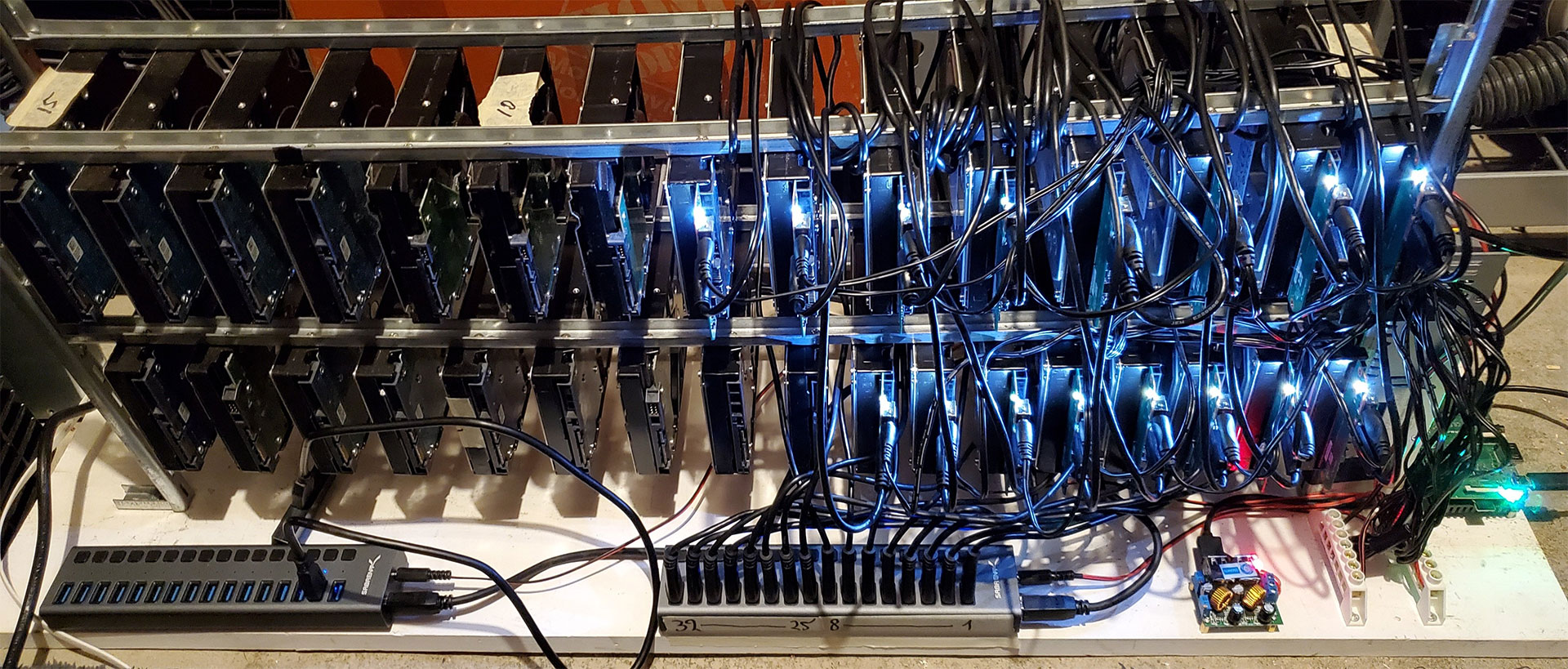
Then far we've focused on the hardware needed to get plotting, which is the more than difficult part of Chia farming. Once you're finished edifice your farm, though, you lot'll want to look at ways to efficiently go on the subcontract online. While it's possible to build out PCs with dozens of HDDs using PCIe SATA cards and extra power supplies, or using USB hubs and USB drives, it'southward likely far easier and more efficient to skip all that and use a Raspberry Pi to farm Chia Coin.
That'south really a recommended long-term farming solution (opens in new tab) from the Chia creators. Above is an example 96TB farm consisting of 30 USB-continued HDDs of varying capacities running off a unmarried Raspberry Pi 4. We'd suggest syncing up with the Chia blockchain and then manually copying the database over to your Pi setup to become started, as otherwise it can accept a while to become going (in our experience at to the lowest degree).
You could just use a regular Windows PC, of form. You'd exist limited to all the same many SATA ports are on your motherboard if you get with internal HDDs, which could be partially overcome by adding PCIe SATA cards. But again, using USB drives and USB hubs (with or without the Pi) overcomes that limitation. In that location's the added benefit of non overloading the 5V rail on a PSU, since the USB hubs should have their own power as well.
And once you lot're finished building out a farm, the power costs to keep dozens of hard drives connected and running are relatively niggling — you lot could probably run 50–100 HDDs for the same corporeality of power every bit a unmarried RTX 3080 mining Ethereum.
Installing Chia
The first step naturally is to install Chia. We're using Windows, though it's available on MacOS and can be compiled from source code for diverse Linux platforms. Once installed, you'll demand to let the blockchain sync upwardly earlier y'all can go to work on farming. Once Chia's installed, y'all'll demand to create a wallet (which in our experience can sometimes be a bit finnicky, just information technology should eventually piece of work).
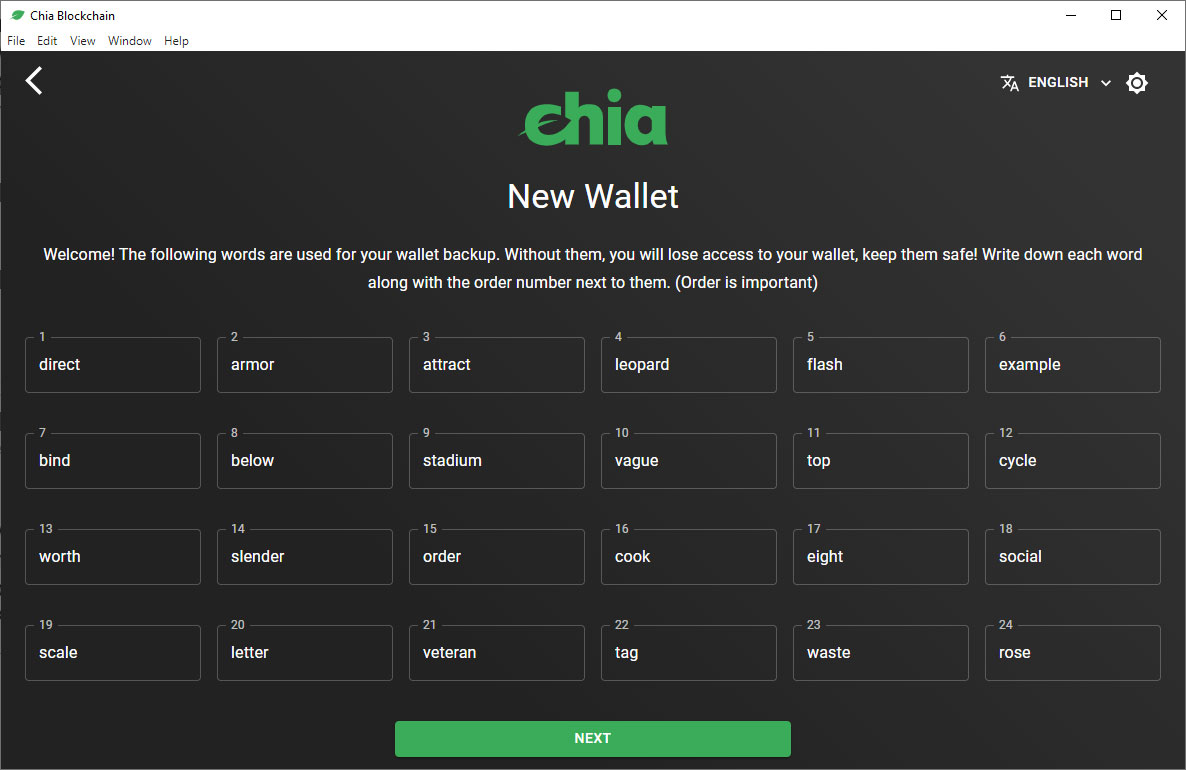
You'll need to create a new private key to get started — don't employ the higher up key, as anyone else on the 'net tin just steal any coins you farm. Screenshot and/or write down your 24 give-and-take mnemonic, equally that's the only way y'all can regain access to your wallet should your PC dice. Store this in a safe and secure place!
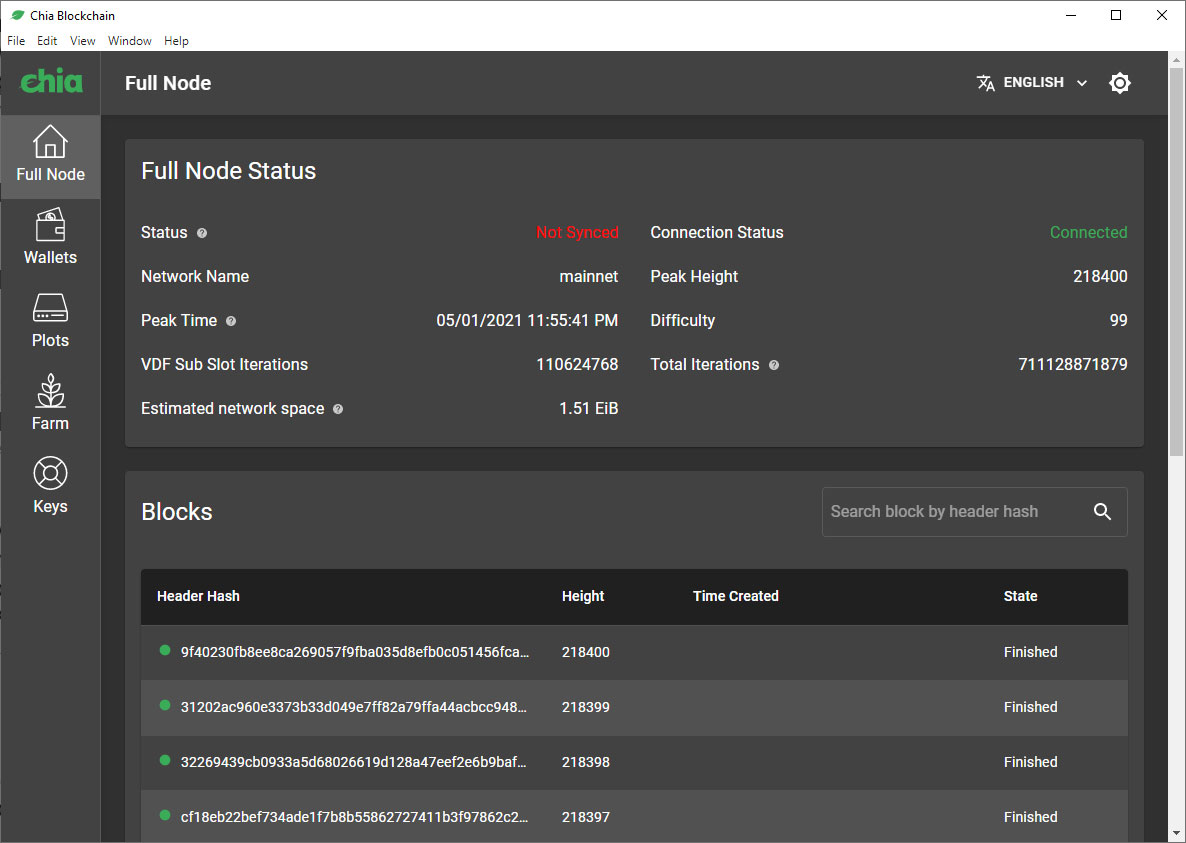
Next, yous'll see the main folio. Every bit noted above, it can take quite a while to sync up, and any information displayed on this screen prior to having the full blockchain won't be current. For example, the higher up screenshot was taken when the total netspace was only 1.51 EiB (mode dorsum in the early on days of Chia). This is also a screenshot from the pre-pooling days, and so let'due south just assume you've figured out the residuum of the installation process and are ready for the real deal.
Chia Pools Take Finally Arrived, Hither'south How to Get Started
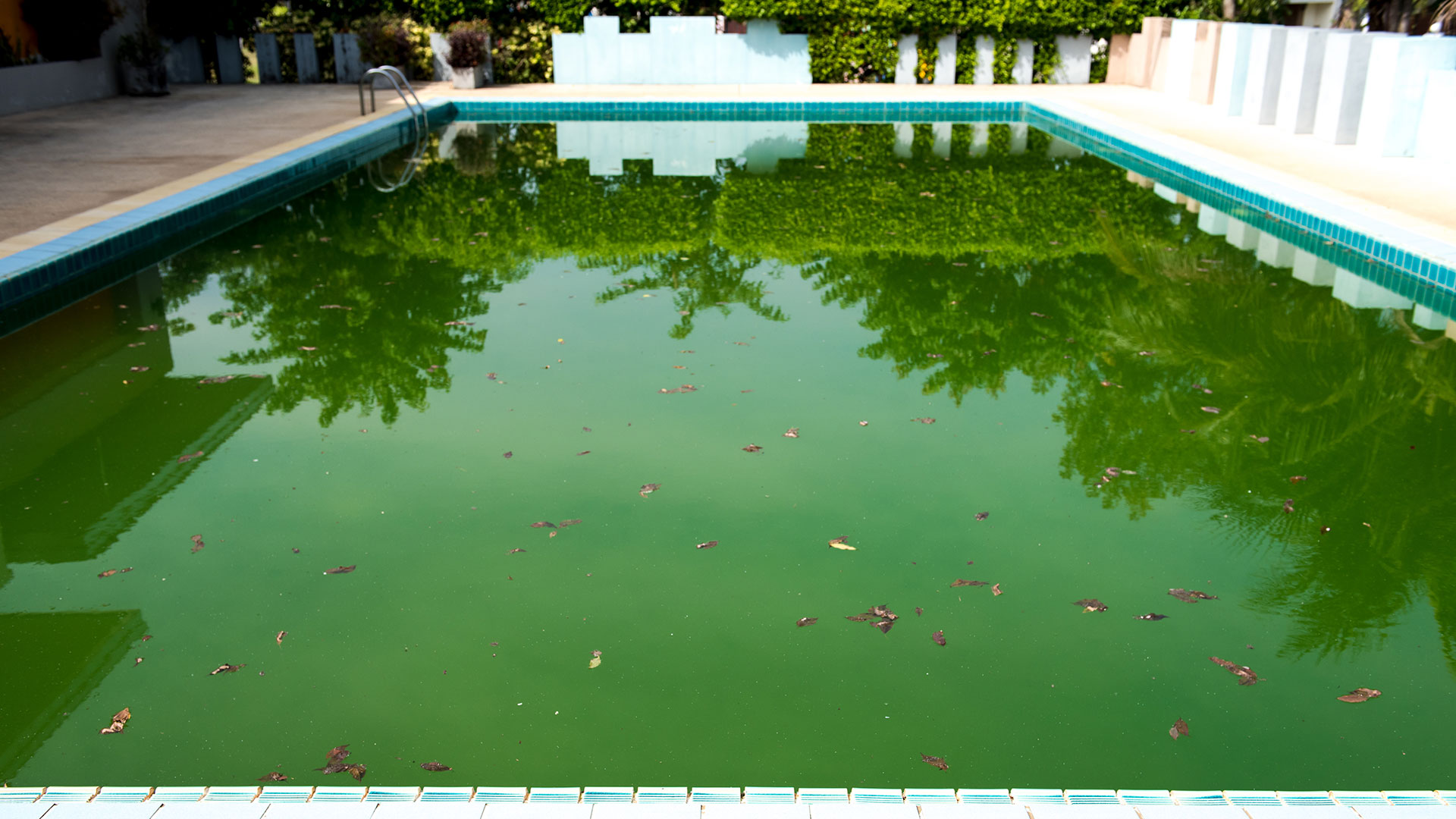
Afterward several months of waiting and delays, pooled Chia farming has finally arrived. Perhaps information technology'southward too picayune, too late for some people, just we tested it and can confirm it's working. Rewards don't seem to be as loftier equally what the Chia calculators estimate, but then once again, annihilation is higher than the 0 XCH per day you're likely to get farming solo.
Bear in listen that in that location are pre-existing pools that don't apply the official pooling protocol. We'd avoid those, and our instructions here are for how to join up using the standard congenital-in pooling functionality that has been bachelor since build 1.2.0 (July vii). To go started with a Chia pool, information technology helps to have a list of available options. MiningPoolStats (opens in new tab) has what yous're looking for, and you'll near probable want to select one of the pools that shows the "Official Pooling Protocol" logo.
By and large speaking, the larger the piece of the pie that a pool has, in terms of netspace, the more regular your payouts will be. Space Pool currently has 223 Atomic number 82 of plots, for example, the almost of any pool using the official protocol. HPool, which developed its own custom software right near the get-go of Chia farming, still controls almost a third of the known netspace, but that per centum is slowly dropping.
Unfortunately, before y'all tin can join a pool, you'll demand to become a Chia wallet up and running. If yous just install the software and try to sync normally, it can have more than a day just to download the current blockchain. (Chia is slow that way, at least for now.) I recommend doing a search for "speed up Chia sync by downloading" so looking for someone with a Torrent or other download that's reasonably upwardly to appointment. That should go you synced up with the blockchain potentially inside xx–30 minutes, only that'south simply the showtime step.
Next, as noted higher up, you have to create a wallet — but now you have to let that sync as well. On a Core i5-11400 system, that required well-nigh half a day. Yeah, that's only to sync up your wallet with the first iv months of data. Fifty-fifty on a faster PC, it'south still 8 hours or more to do a wallet sync. Frankly, this could kill Chia long before people complain about the lack of meaningful any farming rewards. Imagine having to look xxx hours to sync up after the first twelvemonth, or 90 hours afterwards the get-go three years. Hopefully this tin be fixed with future updates, but like the lack of pools, this feels like something that should have been addressed prior to launch.
Once your wallet is all synced up, yous can finally work on joining a puddle. You'll need a pocket-size corporeality of Chia, chosen 'mojo,' to go started. There are various Chia faucets that will give you anywhere from 100 to 500,000 mojo once per day. Feel free to striking them all, using your wallet accost from the GUI, merely do note that even 500,000 mojo is currently only worth most $0.000115. The mojo is required to create a smart pooling contract, however — even just one mojo is sufficient.
You can create the NFT plot either via the GUI or the command line. For the GUI, head to the Pool tab on the left, and bold this is your commencement time here, you'll see the above options. Click join a pool, and if y'all don't accept any mojo, y'all'll go a link to the master Chia faucet where you lot can get 100 mojo. If you lot already have some XCH, either via a faucet or from solo farming, become the third screen that allows you to specify the pool address. This needs to be the full https URL, and if it's a valid Chia puddle, y'all should get some additional details one time you paste in the URL.
Alternatively, to create a pool contract from the command line, open a command prompt and head to the binder for the currently installed version of Chia:
cd "%LOCALAPPDATA%\chia-blockchain\app-1.ii.1\resources\app.asar.unpacked\daemon"
Then type:
chia.exe plotnft create -s puddle -u [URL]
Either way, information technology will accept a few Chia blocks to ostend the cosmos of your pooling contract, and so it should show up in the Chia GUI.
At this point, you likely have no pool plots. If you were early to Chia and accept hundreds of solo plots, you lot'll probably want to systematically delete those and supersede them with pooling plots. Yeah, that means you go to put extra vesture and tear on your SSD storage by replotting, though nosotros knew this was going to happen every bit early equally May. Nosotros previously had a section with instructions on how to create solo plots, along with suggestions on the optimal fashion to do so, but that's at present all out of engagement thanks to the MadMax plotter.
Creating Pooled Chia Plots With the MadMax Plotter
So far, we've mostly glossed over the actual process of creating plots and farming Chia. It's non terribly complicated, just there are some potential pitfalls. One is that the plotting process can't exist paused and restarted, so your plotting PC should be running basically 24/7. Second, and possibly more than importantly: The built-in plotter is rubbish. Oh, it will get the job done, but it takes an eternity, significant in that location'southward a greater risk for things to go incorrect and yous end up losing a lot of time. Information technology tin can take six or vii hours per plot, sometimes more, and even though you lot can potentially practice six or 10 or more than plots at the same time, that requires more than expensive SSDs, CPUs, and RAM. That's where the MadMax plotter comes into play.
There are multiple variants of the MadMax plotter now, and while I can't vouch for all of them — and older versions can't created pooled plots — I've successfully used the v0.1.i release from Stotiks (opens in new tab). Conveniently, you lot don't even need Chia or annihilation else installed. Simply download that and extract it somewhere, and open up a command prompt.
Once y'all've generated an NFT plot contract (see above), that's all you need to make use of MadMax. Get your NFT address from the GUI or from the command prompt. From the GUI, head to the pool tab, mouse over the question mark next to the plot NFT you want, and you can click to copy that. But since you're going to end upwards at the command prompt anyhow, merely go to the current Chia installation folder (e.g., "cd AppData\Local\chia-blockchain\app-1.2.1\resources\app.asar.unpacked\daemon") and type:
chia.exe plotnft prove

The address you want from the above listing is the "P2 singleton address" — for the plot NFT you're planning to create plots with, naturally. Also this address, also called the contract address, you lot'll need your public farmer address too. Get that by typing: chia.exe keys testify You'll desire the public farmer primal.
With both the contract address and farmer keys in hand, you can at present create plots using MadMax's plotter. Go to the appropriate folder, and you can run chia_plot.exe --help to get a list of the diverse options. Then y'all'll desire to run the plotter, specifying the number of plots to create (-n), the number of CPU threads to utilise (-r, commonly best to utilise the number of physical cores in my experience), the temp folder on your SSD for plotting (-t), a secondary temp binder if you have a 2nd fast SSD (-2), the destination folder for the finished plot (-d, your hard bulldoze folder), the plot NFT accost (-c), and your farmer public key (-f). So:
chia_plot.exe -n [number_of_plots] -r [number_of_threads] -t [TempDrive] -2 [TempDrive2] -d [DestinationFolder] -c [P2 Singleton_Address] -f [public_farmer_key]

This is where the speed of your CPU, SSD, and retention volition come into play. Doing some non-entirely-scientific testing (meaning, I didn't try to control for all variables), I saw finished plot times of around 26 minutes on an 18-core, 36-thread Core i9-10980XE with an Intel Optane 905p 480GB SSD. It wasn't overclocked, and the CPU ran at around three.8GHz during plotting, and from what I tin can tell a 10-core, 20-thread Cadre i9-10900K could be nigh every bit fast.
As a second information indicate, using a different (slower) consumer SSD — an XPG SX8200 Pro 2TB that's mostly full of game data (the original variant, non the later slower model) — with a Core i9-9900K, plotting speed was around 70 minutes. That'southward quite a chip slower, but I believe the SSD being total combined with simultaneous read/write speed was the limiting factor. That same CPU and PC plotting to a mostly empty SATA SSD (Samsung 850 Pro 2TB) meanwhile took 112 minutes.
We haven't tested a lot of other SSDs for plotting speed with MadMax, but having a PCIe Gen4 SSD in a Ryzen 5000 system ought to bear witness quite strong. The difficulty with your SSD choice is that you lot'll want to residue that speed with endurance. A super fast SSD that wears out its NAND after 600 plots would be a problem. It's why we ended up going with slower enterprise SSDs that are rated for significantly college endurance. Plus, from what nosotros've seen, concurrent read/write speeds of around 1GBps are all that's necessary for sub-30 infinitesimal plot speeds. Anyway, your mileage may vary, just fast SSDs with loftier endurance are important, and also generally a lot more more expensive.
Of course, you should also make sure the final destination for your plots is an surface area that'south registered in the Chia app. If it is, the new plots should automatically get picked up and commencement earning pooled rewards. Check with your puddle's stats page to verify it's working, though it can take a fleck for the first rewards to start showing up.
Chia Farming on Multiple PCs (Chia Harvesters)
The in a higher place should go you up and running with a Chia subcontract on a single PC, but as you've now doubtfulness gathered by now, it can take a while to fill your HDDs with plots. While information technology's technically possible to put together boosted PCs and so install Chia on those as well, using the same 24-word mnemonic, at that place'south a ameliorate style. That meliorate way is a Chia harvester.
The thought is simple plenty: You're better off with a unmarried Chia node on your network that handles all of the challenges and updates. Even though the Chia network traffic doesn't use a lot of bandwidth, there'due south no sense in having multiple PCs (particularly for a large farm) all trying to sync up. The current blockchain size has already breached 3.2GB of chapters, and it's only going to abound larger over time.
Ideally, y'all want to choose your fastest PC for the full Chia node, so configure all of the other PCs on the network equally harvesters. These will indicate at the principal node and won't require synchronization and all the other extra stuff. Likewise, yous'll be best off if yous ditch the GUI and go comfortable with the command prompt. Thankfully, information technology's not specially difficult. (Props to
this videoand the
Chia Wikifor the base instructions, though nosotros'll try to make things as up-to-date as possible.)
First, get your primary Chia node up and running as above — cipher needs to change there. Getting synced up with the blockchain takes a while, just you lot can start generating plots before that process is completed. For the secondary harvester nodes, start by installing Chia the same as above, but when you're presented with the primary interface that asks y'all to create a new fundamental or import from a mnemonic, merely go out the program and so open up a control prompt — or a PowerShell prompt will also work.
There are a few things yous'll demand. Starting time, you lot need the CA (Certificate Authority) folder from your main node. You can share this over the network, though that's not necessarily the nearly secure way of doing things — but if you're just running a subcontract out of your dwelling house, it likely won't affair. You'll also need to know the name and IP address of the master Chia PC, so let's start there. Open up your PC'due south "About" screen (Win+10, then Y on Windows 10; alternatively, Win+I to open up the Settings app, then click on System and then About).

By default, if you've never actually named your PC (shame on you!), it will exist something hard to retrieve like "Desktop-AH81JFG" or whatever. You should requite it a proper name at present, though, like "ChiaFarmer" or "DontLook" or whatever y'all fancy. You'll need to reboot. Also, while we're here, you should have your main PC hardwired with Ethernet. Information technology's not that y'all can't use Wi-Fi, but latency is usually at least a few ms lower on wired connections, and latency tin can make a difference.
Back to that CA business organisation, let's share the binder. On the main Chia farming PC, open the run dialog (Win+R), so type in "%USERPROFILE%\.chia\mainnet\config\ssl" to get the Chia configuration binder you lot demand.

Correct-click on the CA folder, then Properties, and so click to the Sharing tab. We prefer the "Advanced Sharing" dialog, then tick the Share this folder option, modify the name if you lot want (the default "ca" should be fine), and click Permissions. Remove "Everyone" from the listing, and then click Add, type "Authenticated Users" and printing the Check Proper noun push button, so press OK. At present only PCs that know a user account and countersign for your PC can admission your share — you do have a Windows countersign configured, right? (If not, shame on you once again and go set up that.)
Now nosotros're set to set upwardly the secondary PCs. Open a command prompt (Win+R, and then type "cmd" and press Enter) or PowerShell prompt (Win+X, then press "I"). We need to change to the main Chia folder on this PC, so type:
[Control Prompt:] cd "%LOCALAPPDATA%\chia-blockchain\app-1.2.1\resources\app.asar.unpacked\daemon"
[PowerShell:] cd "$ENV:LOCALAPPDATA\chia-blockchain\app-1.2.i\resources\app.asar.unpacked\daemon"Note that if you're running a newer version of Chia, you lot'll need to change the "app-i.ii.1" part of the control. You're now in the directory where we can configure the harvester. We likewise demand to know the IP address of the master Chia PC now, and so type:
ping -four [Chief PC Proper noun]You should see an IP address with a response, like the following:
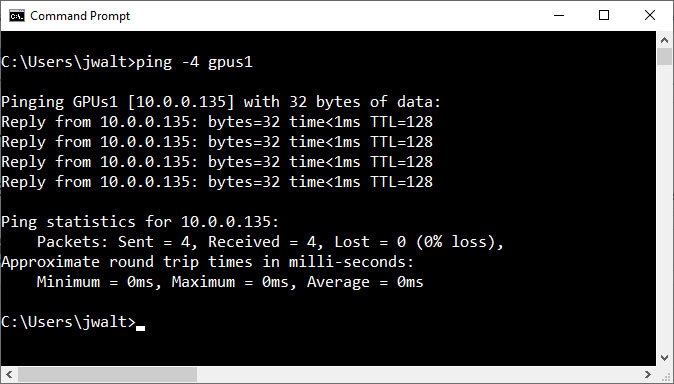
My example PC's IP address is 10.0.0.135. Yours may exist similar, or it might be 192.168.1.xxx, or it could be something entirely different. Any the number, it should be consequent for all future PCs you configure — if your home DHCP server (either your router or your cable or DSL modem) periodically reassigns IP addresses, though, you should expect into configuring a static IP address for the main PC.
That's a topic yous'll have to handle on your own, as information technology tin vary depending on your network hardware. Short summary: Configure your DHCP to exclude a range of IP addresses, and then fix your master PC via the network adapter properties and the IPv4 settings to use a static IP address in the excluded range, with the router/modem IP as the gateway. Alternatively, if your router allows yous to assign specific PCs to an IP address, y'all can do it that way.
Now let'south get the Chia harvester ready. Type:
.\chia.exe stop all -dThis volition ensure Chia isn't running (it shouldn't be). Y'all can also see what locations are being scanned for plots on this node by typing:
.\chia.exe plots showJust typing "chia" or ".\chia.exe" will as well print out the list of options, and yous can bank check the parameters for those options by appending -h (due east.g., ".\chia.exe plots -h"). Another potentially useful command: ".\chia.exe plots cheque" will test all of the plots — and tell you how many there are — to ensure they're all valid. Alert: If yous take a lot of plots, that will have some time. Just here'south the actual of import scrap, configuring the harvester node options. Type:
.\chia.exe init -c [Your CA folder location]

In my instance, you can run into that information technology imported the CA configuration files from the master PC (Ryzen5900X) to the local PC. We're well-nigh washed. Now type:
.\chia.exe configure --set up-farmer-peer [Main PC IP Accost]:8447The ":8447" part specifies the port to use, which by default is 8447 — y'all can change that, merely that's beyond the telescopic of this tutorial. We're nearly finished. One final command:
.\chia.exe outset harvester -r

This will kickoff your secondary PC as a harvester node, and the "-r" is to restart (just in case). When that completes, go over to your main PC's Chia app and visit the Farm screen and you should exist able to see your active harvesters. Nearly every x seconds, the Chia network should result a new claiming that your main node can now answer to, along with checking all of the attached harvester plots. Bold all goes well, y'all're at present in a better place to successfully farm blocks.
Starting Chia Harvester Automatically
If yous're trying to ready a 'permanent' harvester node, though, you probably want to schedule the higher up harvester launch to automatically kick off when the PC boots upwardly. That'south non besides hard, using Windows' Chore Scheduler. My instructions are like to what you lot'll see in this video, though I've tweaked a few items. Become ahead and launch that. You'll exist greeted with the post-obit screen (resize and modify the layout equally needed and so you can meet everything).

That might await a chip scary, but yous tin can ignore everything that's already in in that location. Head over to the correct and click Create Task… to add a new scheduled particular. The post-obit gallery will have all the private screenshots, but let'south just walk through them.
On the Full general tab, give your task a name, something catchy like "Kickoff Chia Harvester." Yous tin as well add a description if you want, but it'southward not required. Check the option for running whether the user is logged in or non, and configure it for Windows 10 (probably not necessary, but but in example). Next, on the Triggers tab add a new trigger, set it to "At startup."
The Actions tab is where the most of import bits are, like what we actually want to run. Click the New… push, and so in the Program/script box blazon "powershell.exe" and in the Add together arguments box put the following:
-executionpolicy featherbed -NonInteractive -NoExit -command "C:\Users\[Username]\AppData\Local\chia-blockchain\app-i.two.1\resources\app.asar.unpacked\daemon\chia.exe start harvester"
That launches PowerShell, the enhanced replacement for the onetime control prompt, and tells it to skip the execution policy, don't permit user interaction, don't exit when the command finishes (because if it exits, so do sub-processes like the command nosotros're launching), and then finally the actual "chia start harvester" command. Note that if you're running a different (newer) version of Chia you'll need to change the "app-1.ii.1" part as appropriate.
Finally, on the Conditions tab uncheck the "Start the task only if the computer is on AC power" (unless you lot're using a laptop and you want information technology to not run while on battery ability, peradventure). You can also check the "Start only if the following network connectedness is available" set to "Whatsoever connexion." (Note that it volition terminate if you lot happen to lose network connectivity, though, fifty-fifty for a few seconds.) And so on the Settings tab, cheque the "Run task every bit soon as possible after a scheduled start is missed" (this is in example your network connection was down), and besides uncheck the "Stop the task if information technology runs longer than:" box (because we don't want it to stop, ever).
Click the OK button and yous'll exist prompted for your user login credentials, and then that the job can run even when you're not logged in. If you want to test things at present, go ahead and restart the harvester PC. Assuming yous take at least a few plots on it, one time it's up and running again yous should be able to go to the principal PC and see entries for information technology on the Farm tab (currently the only real indication is the number of plots on each harvester).
What if you lot want to add more plots to a harvester? While it's possible to do then via the GUI, that sort of gets dorsum into the original mess of having the GUI running on every PC! You tin can add plots via the command prompt, though, using the same instructions for the MadMax plotter as above.
A final word of caution most edifice a big Chia coin farm here. Just because you've got a Chia farm upwards and running, don't look massive rewards. We've gone over the numbers already, but the returns for 10TB of plots correct at present are averaging around $0.50 per day, and that'southward likely to drop. Even with pooled farming out at present, profitability has taken a nosedive over the by month or so — just like what we've seen with Bitcoin and Ethereum.
If you accept a bunch of unused storage sitting around, and yous don't mind putting a bunch of wear and tear on some fast SSDs by making Chia plots, have at it. Simply don't exist shocked if yous fail to strike it rich.
Chia Farming: The Bottom Line

Equally nosotros stated when Chia trading went live in early May, looking at that income potential back them told us 1 thing loud and articulate: More people were going to jump on the bandwagon. And they did. Now prices on storage have gone up, merely more critically, the netspace (difficulty) of farming Chia skyrocketed. Peradventure things volition improve again, but right now, we strongly suggest confronting buying any new hardware for the purposes of farming Chia. If you've already got the hardware, sure, go ahead in utilise it. Merely the toll for hundreds of TB of storage makes the bulwark to entry far too high to recommend.
During its first week of trading, Chia started with a price (opens in new tab) of around $1,600, climbed upwardly to a meridian of around $i,900, and then dropped to a minimum value of around $560. It stayed relatively stable at around $600–$800 for a while, more exchanges have joined the initial trio every bit well, daily trade volumes have gone up, and netspace ballooned faster than most people expected. But in the past month, the price savage into the $200–$300 range and it could stay there a long time — or autumn even further.
At the time of this latest update, with Chia pooling now alive, Chia's cost sits at $235 and the netspace has eclipsed 30 EiB. In may, a 10TB hard drive of plots could have theoretically paid for itself in nearly two months; now, it would accept about a year to suspension fifty-fifty on the cost of 10TB of storage, and netspace continues to climb.
Dissimilar other cryptocurrencies, Information technology takes quite a bit more effort to bring more Chia plots online, and we've seen an incredibly fast ramp in allocated netspace. Things are starting to irksome down, though. Where growth was lxxx% per week a few months back, that has trended down and nosotros 'just' saw a 5% increase over the by week. As farmers switch from solo to pooled farming and are forced to replot potentially all of the existing netspace, we're fifty-fifty seeing flat or negative growth right now, but that should eventually reverse.
That brings united states back to the terminal point. Chia is supposed to be a 'green' cryptocurrency, because it doesn't utilize as much power to run a hard drive as it does to run compute calculations on a GPU or ASIC. Chia does drastically cutting dorsum on the power requirements relative to Bitcoin, right at present, but 30 EiB of netspace already means probably 3.0 1000000 HDDs, each consuming well-nigh 5W. That's already approximately 360 MWh per day. Bitcoin uses about 1,000 times every bit much power, just with all the power used on plotting every bit well, not to mention concerns with due east-waste on the burned out SSDs, well... this doesn't really experience whatever more than green than an electric vehicle powered past energy from a coal called-for power plant.
We too accept serious concerns with the corporeality of fourth dimension it at present takes to sync up with the Chia blockchain. Half a day to become a new wallet synced upwards with a bit less than 4 months of data, much of which shows far fewer transactions than we might see in the future? That could critical limit growth and adoption of Chia in the coming years, and if a cryptocoin doesn't get used, information technology'southward just a bunch of useless zeroes and ones.
Source: https://www.tomshardware.com/how-to/how-to-farm-chia-coin-the-new-storage-based-cryptocurrency

0 Response to "How Many Chia Plots Per Tb"
Post a Comment